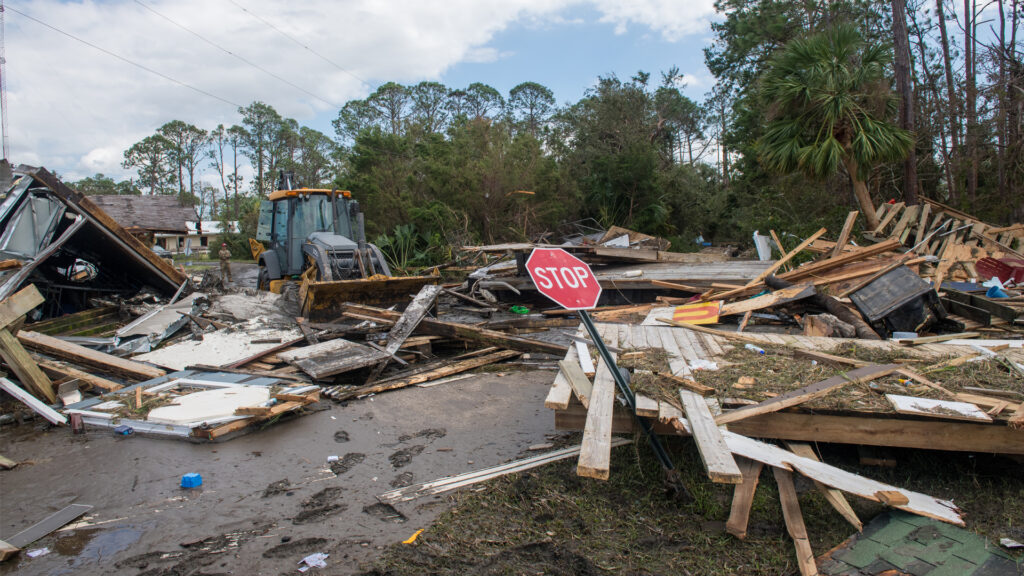By Nahuel Arenas, U.N. Office for Disaster Risk Reduction
Florida is no stranger to disasters. From hurricanes and flooding to extreme heat, the state experiences the devastating impacts of climate-driven hazards year after year.
In 2024 alone, Florida faced significant damages from hurricanes Helene and Milton, underscoring the urgent need to shift from reactive disaster response to proactive disaster risk reduction (DRR).
The economic toll of these disasters is staggering. Hurricane Helene, which struck the Big Bend region in September 2024, caused widespread damage, including the destruction of 90% of homes in Keaton Beach and significant losses in Gulfport and Tampa Bay.

In total, damage across Manatee and Sarasota counties was estimated at over $1.1 billion. Just weeks later, Hurricane Milton made landfall, worsening the state’s challenges. These back-to-back storms devastated communities and strained Florida’s economy, leading to a decline in consumer confidence and exposing vulnerabilities in infrastructure, as reported by local media.
This pattern is not unique to Florida; it reflects a global crisis.
The 2024 Regional Assessment Report on Disaster Risk in Latin America and the Caribbean (RAR24), published by the United Nations Office for Disaster Risk Reduction (UNDRR), reveals a troubling risk trend: According to CDRI, the global average annual losses on infrastructure are estimated to be over $700 billion, with climate-related hazards responsible for 75% of these costs.
In the United States, disaster-related average annual losses reach $112 billion, underscoring the growing economic toll of disasters. Yet, despite these risks, investment in prevention remains critically low.
In Latin America and the Caribbean, disaster-related losses total, on average, $58 billion annually, but only 6% of public budgets for DRR go to prevention. In comparison, 78% is spent on response and reconstruction. This cycle of destruction and rebuilding is unsustainable.
Shifting financial priorities toward prevention is key to breaking this cycle. Early warning systems, resilient infrastructure and nature-based solutions have already proven to be cost-effective in reducing economic losses. Moreover, strengthening public-private partnerships to expand disaster insurance coverage is critical, as currently, only 5% of disaster-related losses in developing countries are insured, compared to 40% in developed nations.
In Florida, as in many other hazard-prone regions, this means ensuring that public investments consider disaster risk from the outset, integrating resilience into infrastructure, housing and urban planning. It also requires scaling up preparedness programs at the local level, particularly in vulnerable communities, where proactive measures can significantly reduce human and economic losses.
As extreme events accelerate the frequency and intensity of extreme weather events, Florida’s exposure to hurricanes, rising sea levels and prolonged heat waves make proactive investment in resilience a financial necessity.
Recent studies have shown that early warning systems can cut disaster-related economic losses by 30%, while resilient infrastructure — such as improved building codes and flood-resistant transport — lowers reconstruction costs. Nature-based solutions, like wetlands restoration, are also 50% more cost-effective. Yet, these solutions remain underutilized, leaving communities and economies increasingly vulnerable to disasters.
The need to rethink how we finance disaster resilience was a main topic at the recent Miami Disaster Expo USA, where I was the keynote speaker. At the expo, policymakers, private sector leaders and experts gathered to discuss practical solutions. These spaces are essential for fostering collaboration and identifying strategies to continue pushing the shift from reactive disaster response to proactive risk reduction.

At the same time, Florida, like the rest of the world, must recognize that investing in DRR is not an expense but a strategic necessity. Strengthening resilience saves lives, protects infrastructure and ensures economic stability.
Significantly, DRR must go hand in hand with humanitarian action to ensure that when disasters strike, communities — especially the most vulnerable — receive timely assistance and support.
The costs of inaction continue to mount, straining public budgets, displacing communities and deepening social and economic inequalities. Every dollar invested in disaster prevention saves up to four dollars in reconstruction costs, making DRR one of the most effective investments a government can make.
Prioritizing resilience today will shape the safety and prosperity of future generations.
Nahuel Arenas is the chief of the United Nations Office for Disaster Risk Reduction at the regional office for the Americas and the Caribbean. He was a speaker at the recent Miami Disaster Expo. This opinion piece was originally published by the Miami Herald, which is a media partner of The Invading Sea. Banner photo: U.S. Airmen clear roads in Keaton Beach after the landfall of Hurricane Helene (Staff Sgt. Jacob Hancock/U.S. Air National Guard, via Defense Visual Information Distribution Service).
Sign up for The Invading Sea newsletter by visiting here. To support The Invading Sea, click here to make a donation. If you are interested in submitting an opinion piece to The Invading Sea, email Editor Nathan Crabbe at nc*****@*au.edu.



